Do you struggle with writing SEO content? Would you be interested if I show you how to optimize content for SEO?
If your answer is yes, then welcome because you’re about to learn my simple step-by-step process on how I use the Rank Math SEO plugin to optimize my blog post for SEO.
There’s no doubt that content optimization has a lot of benefits. However, implementing effective SEO strategies is not only complex but also time-consuming. This is where Rank Math SEO comes in.
Rank Math gives you an array of SEO tools and features that enable you to fine-tune every aspect of your blog post. From optimizing post titles and URLs to structuring your content effectively, Rank Math empowers you to take control of your SEO efforts without needing technical expertise.
Over the past 7+ years of writing content for SEO, I have always had the challenge of knowing for a fact, that the content I’ve written was SEO optimized. However, in the last couple of years since I started using Rank Math, whenever I write my content and before it is published, I have a certain level of confidence that the post is not just user-friendly but is also optimized for SEO.
And so, in this comprehensive step-by-step guide, we'll delve into the world of search engine optimization (SEO) and show you how to leverage the incredible capabilities of Rank Math to optimize your content so that your website or blog can have a better chance in the SERPs.
So, if this is something you want to learn today, then grab a cup of coffee, sit back, and let's get started on optimizing your content for SEO!
Recommended: Liquid Web Reviews (+ The Best Alternatives for 2023)
Table of Contents
What is SEO and Content Marketing?
Before we dive into the specifics of creating SEO optimized content with Rank Math, let's take a moment to understand two key factors in our discussion: SEO and content marketing and why content optimization is so crucial for enhancing website visibility.
SEO (Search Engine Optimization) and content marketing are closely intertwined strategies that work hand in hand to achieve online success. While they are distinct concepts, they are highly complementary and often go together in a well-rounded digital marketing approach.
Search engine optimization is the process of optimizing a website to improve its visibility and organic rankings on search engine result pages. The primary purpose of SEO is to make your website more search engine-friendly, enabling search engines to understand and index your content effectively.
SEO involves keyword research, on-page optimization, technical optimization, and link building, among other tactics. Its ultimate goal is to attract organic traffic from search engines. And, this is very important because 49% of marketers report that organic search has the best ROI of any marketing channel [Search Engine Journal]. In fact, according to another report by BrightEdge, SEO drives 1,000%+ more traffic than organic social media.
Content marketing, on the other hand, revolves around creating and distributing valuable, relevant, and engaging content to attract and retain a target audience. It involves crafting informative blog posts, articles, videos, infographics, and other forms of content that address the needs and interests of the target audience.
So, how do SEO and content marketing intersect?
- Keyword Optimization: SEO relies on keyword research to understand what users are searching for and optimize content accordingly. Content marketing aligns with this by creating high-quality content centered on those targeted keywords, providing valuable information to users while also satisfying search engine algorithms.
- Content Creation: Content marketing produces the material that drives engagement and establishes a brand's authority and expertise. SEO helps guide the content creation process by identifying relevant topics, popular keywords, and user intent. By incorporating SEO best practices into content creation, such as optimizing headings, meta tags, and URLs, content becomes more discoverable and relevant to search engines.
- Link Building: SEO emphasizes the acquisition of high-quality backlinks, which are links from external websites that point to your content. Content marketing plays a vital role in this process by creating compelling content that other websites naturally want to link to, thus amplifying the SEO benefits.
- User Experience: Both SEO and content marketing aim to enhance the user experience. SEO focuses on technical aspects like website speed, mobile-friendliness, and ease of navigation. Content marketing focuses on delivering valuable, well-structured, and engaging content that keeps users on the site longer and encourages interaction.
In essence, SEO provides the technical framework for content to be discovered by search engines, while content marketing ensures the creation and distribution of high-quality, user-centric content that satisfies both search engines and the target audience.
By combining these strategies effectively, businesses can drive organic traffic, increase brand visibility, and foster meaningful engagement with their audience.
What Is Content Optimization?
Content optimization refers to the process of enhancing and refining the content on a website or blog to make it more visible, relevant, and valuable to both users and search engines. It involves strategically improving various elements of the content to increase its search engine ranking and attract more organic traffic.
When optimizing content, several factors are taken into consideration. These include incorporating relevant keywords and phrases throughout the content, optimizing title tags and meta descriptions, using proper header tags, creating engaging and informative content that meets the needs of the target audience, and ensuring the content is easily readable and accessible.
Why Optimize Content for SEO?
As we've seen above, content is the backbone of any successful online presence. But even the most well-written and valuable content can go unnoticed if it's not optimized for search engines. This is why it is important that you optimize your website and marketing content for SEO, whatever that is.
Basically, here are some reasons why you should optimize your content for SEO:
- Increased Visibility: When you optimize your content, it becomes more visible to search engines. By incorporating relevant keywords, meta tags, and other SEO elements, search engines can better understand the content and rank it higher in search results. This increased visibility means more people are likely to discover and visit your website or blog.
- Organic Traffic: SEO-optimized content has the potential to attract a significant amount of organic (non-paid) traffic. When your content ranks higher in search results, it becomes more accessible to users actively searching for relevant information or solutions. This targeted organic traffic can lead to higher engagement, conversions, and ultimately, business growth. For example, a report by HubSpot showed that SEO leads have a 14.6% close rate.
- Improved User Experience: Content optimization involves creating high-quality, informative, and engaging content that meets the needs of your target audience. By optimizing your content, you provide a better user experience, ensuring that visitors find valuable and relevant information on your website. This positive user experience can lead to increased time spent on your site, lower bounce rates, and higher user satisfaction.
- Competitive Edge: In today's digital landscape, competition is fierce. By optimizing your content for SEO, you gain a competitive edge over others in your industry. With proper optimization, your content stands a better chance of outranking competitors and capturing the attention of your target audience.
- Long-Term Results: SEO is a long-term strategy that yields lasting results. While it may take time and effort to optimize your content, the benefits can extend well into the future. Once your content starts ranking higher in search results, it can continue to attract organic traffic and generate value for your business over an extended period. The report by BrightEdge, referenced above, also showed that SEO drives 1,000%+ more traffic than organic social media.
From the above it is clear that optimizing your content for SEO improves visibility, drives organic traffic, enhances user experience, provides a competitive advantage, and delivers long-term results. It is a fundamental practice for achieving online success and reaching your target audience effectively.
Related: Best Practices for Optimizing Keywords for SEO in 2023
Why Rank Math for Content Optimization?
There are a good number of WordPress SEO plugins in the market. However, of all of these, Rank Math stands out from the rest. It is a cutting-edge SEO plugin that revolutionizes the way you optimize your content.
Rank Math SEO is developed by a team of seasoned SEO professionals and digital marketing experts. It offers a comprehensive suite of features designed to streamline your SEO efforts. From keyword research and on-page optimization to advanced schema markup and XML sitemaps, Rank Math combines powerful functionality with an intuitive user interface, making it the ultimate weapon in your SEO arsenal.
In a nutshell, Rank Math takes content optimization to the next level. With its comprehensive set of features and tools designed to simplify and enhance the optimization process, using the plugin ensures that your content aligns perfectly with the latest SEO standards. It doesn’t matter whether you're a seasoned marketer or you are just starting out, Rank Math provides the tools you need to maximize your content's potential.
Related: Rank Math: The Best Yoast Alternative for SEO?
Rank Math's Content Analysis and How It Works
One of Rank Math’s powerful features that makes it stand out for content optimization is the Content Analysis. This is a powerful feature that provides you with invaluable insights and recommendations to optimize your content for better search engine rankings.
When you’re creating or editing a post within the WordPress editor, Rank Math's Content Analysis will evaluate various aspects of your content, including SEO elements, readability, keyword usage, and media incorporation and give you suggestions for improving the content SEO performance. By following the recommendations provided for each test, you can optimize your content for improved search engine visibility, engagement, and overall readability.
Benefits of Rank Math's Content Analysis
Some key features and benefits of the Rank Math's Content Analysis are:
- Keyword Optimization: Rank Math examines the content to ensure it includes the targeted keywords appropriately. It analyzes keyword density, placement, and prominence, providing suggestions to optimize keyword usage for better visibility in search results.
- Readability Analysis: Rank Math evaluates the readability of the content, assessing factors such as sentence length, paragraph structure, and the use of transition words. It offers suggestions to enhance readability, making the content more engaging and understandable for users.
- Title and Meta Description: Rank Math's content analysis checks the title and meta description tags to ensure they are optimized for search engines. It provides recommendations for improving these elements, such as incorporating relevant keywords and maintaining optimal length.
- Headings and Subheadings: Rank Math assesses the usage of headings (H1, H2, H3, etc.) within the content. It offers guidance on properly structuring headings and subheadings for better organization and SEO optimization.
- Internal and External Links: Rank Math's content analysis examines the presence and quality of internal and external links within the content. It suggests adding relevant links to enhance the user experience and improve SEO performance.
- Image Optimization: Rank Math evaluates the optimization of images used within the content. It checks if images have alt tags and recommends including appropriate keywords in those tags for better SEO.
- Content Length: Rank Math provides insights into the ideal content length for better search engine rankings. It considers factors like word count and suggests adjustments to align with best practices.
Rank Math's Content Analysis Categories
Within the WordPress editor, the different tests that the Content Analysis run on your content are divided into four categories:
Category 1: Basic SEO
This category focuses on fundamental aspects of SEO optimization within your content. It includes recommendations related to keyword usage, meta tags, and content structure. The Basic SEO category helps ensure that your content aligns with best practices to enhance its visibility and relevance to search engines. What the plugin checks for in this category are:
- Focus Keyword in the SEO Title
- Focus Keyword in the Meta Description
- Focus Keyword in the URL
- Focus Keyword at the beginning of the content
- Focus Keyword in the Content
- Overall Content Length
Category 2: Additional
The Additional category offers supplementary recommendations to enhance the overall SEO optimization of your content. It covers various aspects beyond the fundamental SEO elements. This checks for:
- Focus Keyword in Subheading
- Focus Keyword in Image ALT Attributes
- Keyword Density
- URL Length
- Linking to External Sources
- Linking to External Content with a Followed Link
- Linking to Internal Resources
- Focus Keyword Uniqueness
- Content AI Test
Category 3: Title Readability
This category emphasizes the readability of your content's title. Rank Math evaluates factors such as length, clarity, and structure to ensure your title is compelling and engaging to both users and search engines. The title readability tests checks for:
- Focus Keyword at the beginning of the SEO Title
- Sentiment in a Title
- Use of Power Word in Title
- Number in Title
Category 4: Content Readability
The Content Readability category focuses on evaluating the readability and user-friendliness of your content. Rank Math provides suggestions to improve the overall readability, making your content more engaging and understandable. This checks for:
- Use of a Table of Contents
- Use of short paragraphs
- Use of Media in Your Posts
For a more detailed explanation of how Rank Math’s Content Analysis works, read this post on the Rank Math official website.
The 7 Steps to Optimizing Your Post for SEO with Rank Math
Having laid the foundation let’s now move on to how you can optimize your content using Rank Math SEO.
Step 1: Install Rank Math SEO Plugin
Of course, if you have not installed Rank Math SEO plugin, you will need to start from here. To install the plugin, follow these steps:
Step 1: Visit the plugin's official website and download Rank Math for FREE
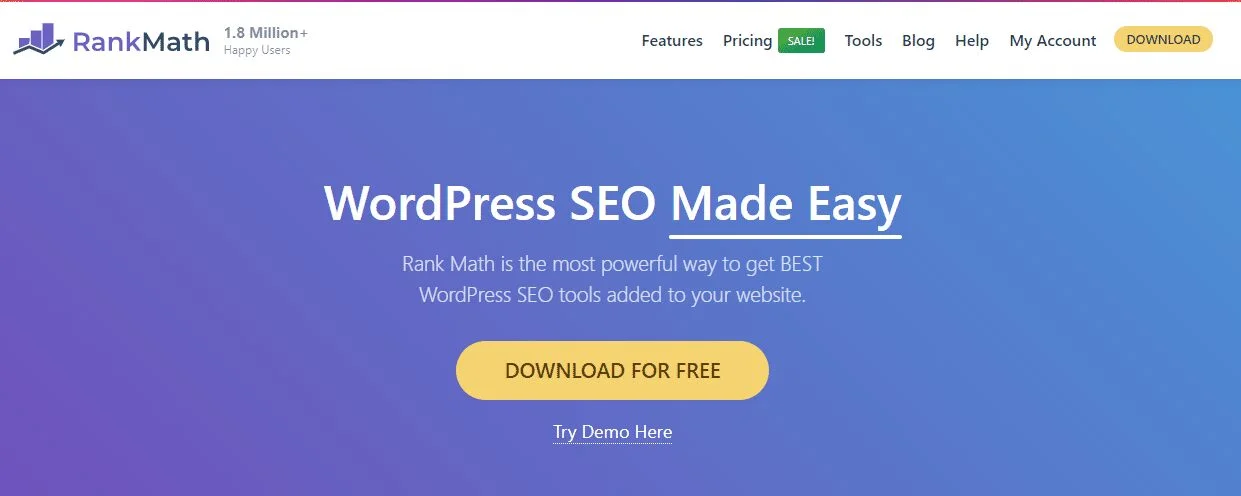
Step 2: Login into your WordPress dashboard and click on “Plugins” in the sidebar menu and then click on “Upload Plugin”.
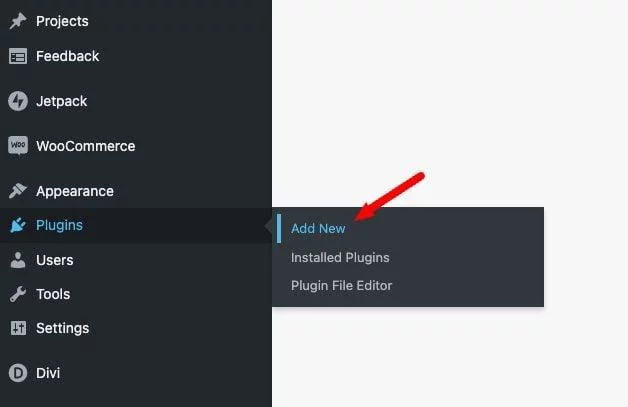
Step 3: Click on “Choose File”, navigate to the where you downloaded the plugin and select it.
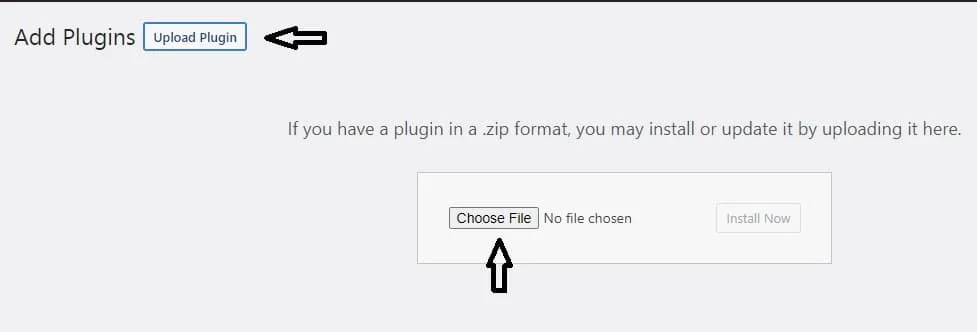
Step 4: Click on the “Install Now” button.
Step 5: When the installation is complete, click on “Activate” to activate the plugin.

After activating the plugin, make sure that you connect your site to Google services like Google Search Console and Google Analytics so that they can track your website's performance accurately. These tools provide valuable insights into your site's visibility, keyword rankings, and user behavior, allowing you to make informed decisions and optimize your content accordingly.
You should also make that your copy of Rank Math is activated. You can do this by creating a free account with Rank Math and then connecting your site to your account. Connecting your site provides additional tools and keyword suggestions, empowering you to optimize your website effectively.
Step 2: Conduct Keyword Research
Every piece of content that you write should begin with keyword research. It involves identifying the terms and phrases your target audience are using to search for information related to your industry or niche. By conducting keyword research, you gain valuable insights into the search demand and intent of your target audience. Here’s a simple guide to conducting keyword research:
- Brainstorm: Begin by brainstorming a list of relevant terms that are closely related to the topic you want to create your content on.
- Use Keyword Research Tools: Utilize keyword research tools like Google Keyword Planner, SEMrush, Ahrefs, or Moz Keyword Explorer to generate keyword ideas. Enter your topic or the terms you have brainstormed above into these tools. This will return a list of related keywords along with important metrics such as search volume, keyword difficulty, and competition.
- Analyze Competitor Keywords: Look at your competitors' websites and analyze the keywords they are targeting. Tools like SEMrush or Ahrefs can provide you with valuable insights into the keywords your competitors are ranking for. Identify keywords that are relevant to your business and have a good search volume but may have lower competition.
- Consider Long-Tail Keywords: Long-tail keywords are longer and more specific keyword phrases that have lower search volume but often indicate higher intent and are less competitive. They can be valuable for targeting specific niche audiences and driving targeted traffic to your website. Include long-tail keywords that are relevant to your content and have the potential to bring in qualified leads.
- Analyze Search Intent: Understand the intent behind the keywords you are targeting. Are users looking for information, products, or services? Analyze the search results for your target keywords and see what type of content is ranking. This will help you align your content with the search intent and provide valuable information to your audience.
Step 3: Create Your Content
Once you have decided on the keywords you will target in your post, your next move is to write the post. You should aim at creating an SEO-friendly and high-quality post. This involves incorporating the relevant keywords, you’ve earlier researched, naturally into your content. This way, the content will resonate with both search engines and human readers. Here are some tips for creating SEO-friendly and high quality content:
- Plan your post before writing – Before you start writing your content, take a moment to think and plan. Consider your target audience, the purpose of your content, and the main message you want to convey. When you have a clear understanding of your content goals, you’ll be able to create a piece of content that resonates with your readers and aligns with their needs.
- Decide on a Structure for Your Post – A well-structured blog post is not only easier to read but also more appealing to search engines. Start by creating an engaging introduction that hooks your readers and clearly outlines what they can expect from the post. Follow it with a body that provides valuable information, insights, or solutions related to your topic. Finally, conclude your post by summarizing the key points and encouraging readers to take action.
- Use Paragraphs and Headings – When writing a blog post, it's important to make it reader-friendly and visually appealing. Use short paragraphs to improve readability and make your content more scannable. Long blocks of text can be overwhelming for readers and deter them from engaging with your content. Within the body of your post, use headings and subheadings (H2, H3, etc.) to break your content into logical sections. This makes it easier for readers to navigate.
- Use Transition Words – Transition words are an essential component of a well-written blog post. They help guide your readers from one idea to another and create a seamless flow within your content. Transition words such as “however,” “in addition,” “furthermore,” and “finally” not only improve readability but also signal to search engines that your content is coherent and organized.
- Expand Your Content's Relevance with Related Keywords – When optimizing your blog post for search engines, it's important to incorporate related keywords alongside your primary target keywords. Related keywords are terms and phrases that are semantically connected to your main keywords and provide additional context to search engines. By using related keywords throughout your blog post, you expand the relevance of your content and improve its chances of ranking for a broader range of search queries.
NOTE: You can write your content directly within the WordPress editor or use Google Doc, before transferring it onto the WordPress editor. Personally, I prefer writing and formatting my posts with Microsoft Word and then copying and pasting it to the WordPress editor.
For example, here’s this post on Microsoft Word:

Recommended: How to Write a Blog Post for SEO Using ChatGPT (The Ultimate Guide)
Step 4: Set Your Focus Keyword
Now that you have written your post and you have pasted it on the WordPress editor, your next move is to optimize it. To begin the optimization process using Rank Math's Content Analysis tool, you need to first set your focus keyword. To do this, access the Rank Math’s Content Analysis tool by clicking the SEO Score button on the top-right corner of the WordPress block editor.
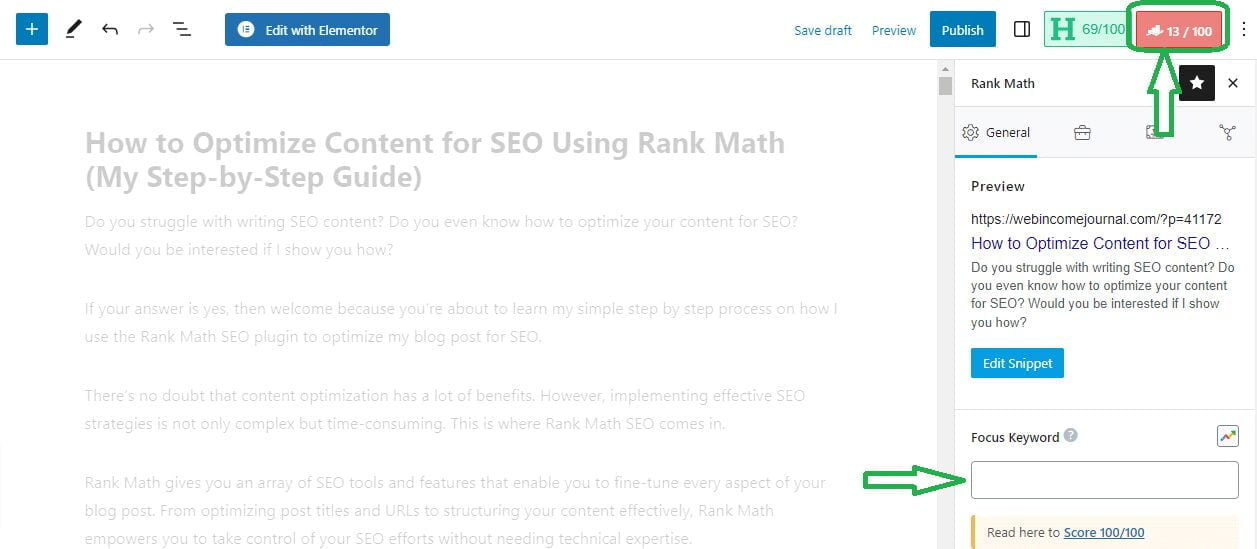
Now, enter your focus keyword. This is the specific phrase or keyword that you are optimizing your content for. You should have picked your focus keyword when doing your keyword research, based on the content you are creating. Also, you should have written your content with this keyword or phrase in mind.
When you enter the focus keyword, Rank Math will analyze your content and give you suggestions on the areas that still need optimization. Please note that while Rank Math allows you to enter multiple focus keywords, it is advisable to enter not more than four or five focus keywords per post. And, all of them should be related keywords so that your content is focused on one topic.
Again, ensure that when you installed the Rank Math SEO plugin you activated your copy by connecting your site to the Rank Math website. If you have done this, the plugin will give your keyword suggestions from your focus keywords that you can further optimize your content with thereby giving your content more fighting power in the SERPs.
Step 5: Optimize Your Post URL, Title and Meta Tags
An attention-grabbing and keyword-rich title is very important when it comes to optimizing blog posts for search engines. By including your focus keywords in your post title and URL, you’re telling the search engines that your content is highly relevant to the search query. This will increase the likelihood of your page being ranked higher in search results.
Besides, having your focus keywords in SEO titles and URLs have a direct impact on user click-through rates (CTRs). When users see a search result that includes their query keywords in the title and URL, it creates a sense of relevance and encourages them to click on your link. This not only drives more organic traffic to your website but also improves your website's overall engagement metrics, such as time on page and bounce rate.
Besides having the focus keywords in your title and URL, you should also include it in the meta description making it enticing for users to click.
With its intuitive interface and the content analysis feature, Rank Math streamlines the process of optimizing your post title and URL for maximum SEO impact. Using the real-time analysis and suggestions provided by Rank Math, you can easily modify your post title and URL and improve it for both search engines and users.
To optimize your post title, URL and meta tags, click on the “Edit Snippet” button to open the “Preview Snippet Editor” . Make sure the title and URL tags are optimized for your target keyword. You should write a compelling meta description while naturally including the keyword.
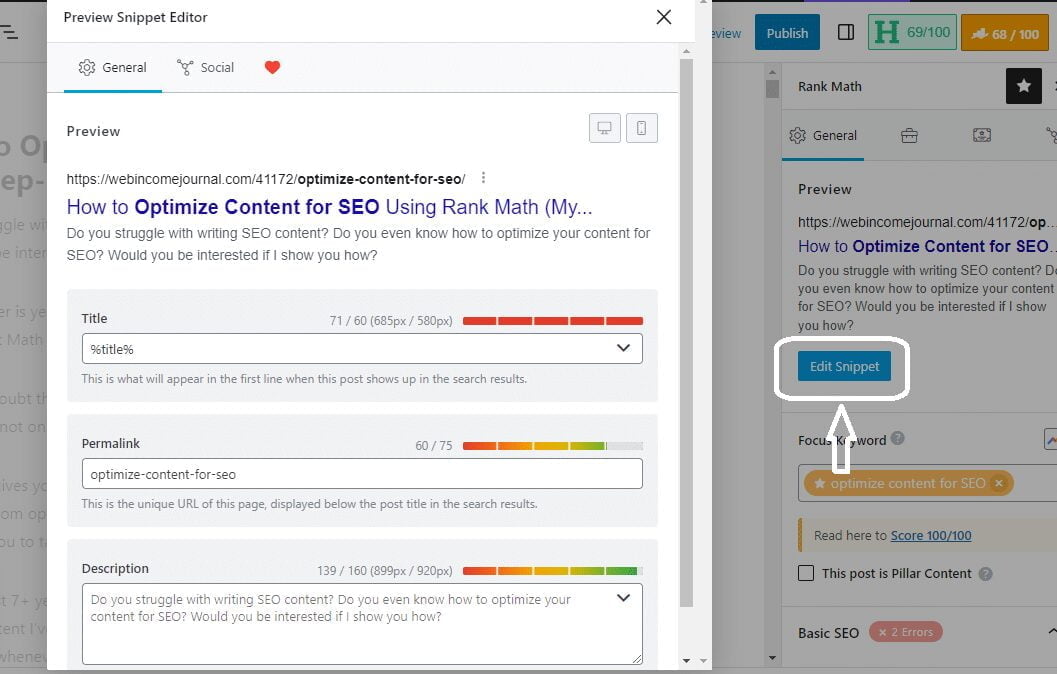
Step 6: Optimize Your Content for Style and Readability
If you have followed the simply guide I gave above when writing your content, then you should have outlined and organized it into clear sections or headings (H1, H2, H3, etc.). Organizing your content this way, makes it more accessible to readers. This is because headings act as signposts, guiding readers through your article and allowing them to quickly grasp the main points and structure of your content.
Headings also make it easy for readers to scan your post because they provide visual breaks in the text, making the content more visually appealing and less overwhelming to readers. This enhances the user experience, encourages longer page visits, and reduces bounce rates.
When Rank Math analyzes your content, theContent Readability test will check if you’re using a Table of Contents plugin, short paragraphs and media in your post. If you have written your content with the suggested tips, then you should definitely have a good score here.
However, you will need to add a table of contents, if your post is a long one. You can easily add this using Rank Math. Click on the “+” sign to add a new block and then search for “table of contents”. Choose the table of contents by Rank Math and it will automatically generate the table of contents based on the headings within your blog post.
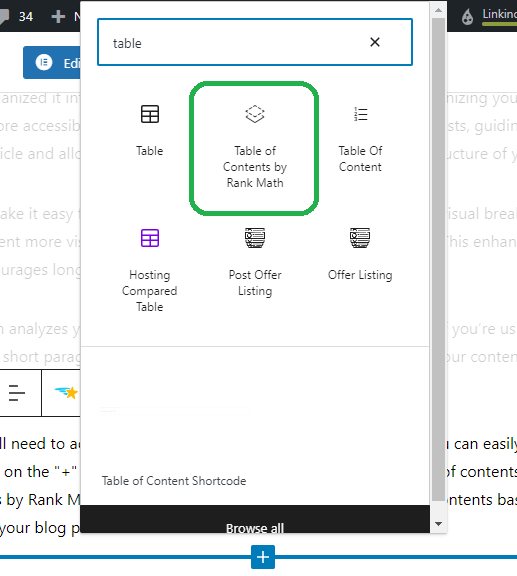
You should also add relevant images and other media, like videos, to enhance the visual appeal and structure of your content. Optimize the images for SEO by using descriptive titles and alt tags, incorporating relevant focus keywords. For example:
- Poor: Title: truck.png; Alt text: moving truck
- Better: Title: loading-moving-truck.png; Alt text: Loading a moving truck with black crates
You may want to watch this short video on How to Optimize Your Content For Your Target Keyword. It's truly insightful:
Step 7: Add Internal and External Links
Internal and external links are very important when it comes to search engine optimization. Internal links connect different pages within your blog. They play a vital role in improving website navigation, guiding visitors to relevant and related content. Some of the benefits of internal links are improved user experience, enhanced website authority, and establishing content hierarchy.
External links, on the hand, are links that point from your website to other authoritative and relevant sources. Including external links in your blog posts is valuable because they create credibility and trustworthiness, establishes relationships andpotentially improve your own search engine rankings.
Rank Math understands the importance of these SEO factors. This is why it checks your content and if there are no internal or external links, it recommends you add them. The plugin also has an option for you to mark your post as a “Pillar Post”. When you do this, related posts will be suggested for you by Rank Math, and you can easily add them to your post.
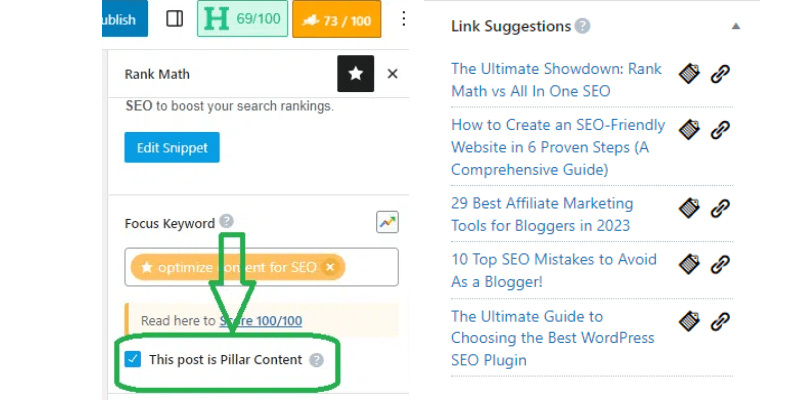
When adding internal links keep this in mind:
- Identify relevant anchor text: Choose descriptive and keyword-rich anchor text for your internal links. This helps search engines understand the content of the linked page and its relevance to the anchor text.
- Use a reasonable number of internal links: While internal links are beneficial, avoid excessive linking that could confuse or overwhelm your readers. Focus on quality over quantity and ensure that the links add value to the user experience.
And for external links you should keep the following best practices in mind:
- Choose authoritative sources: When linking externally, prioritize reputable sources that are relevant to your content and add value to your readers. Look for well-established websites, industry publications, and scholarly sources.
- Use the appropriate anchor text: Ensure that your anchor text accurately reflects the content of the linked page and provides clear context to both readers and search engines.
- Open external links in new tabs: To prevent users from navigating away from your site entirely, set external links to open in new browser tabs or windows. This allows visitors to explore the external content while keeping your website open in the background.
Recommended: 10 Top SEO Mistakes to Avoid As a Blogger!
How Much Rank Math Score Is Good?
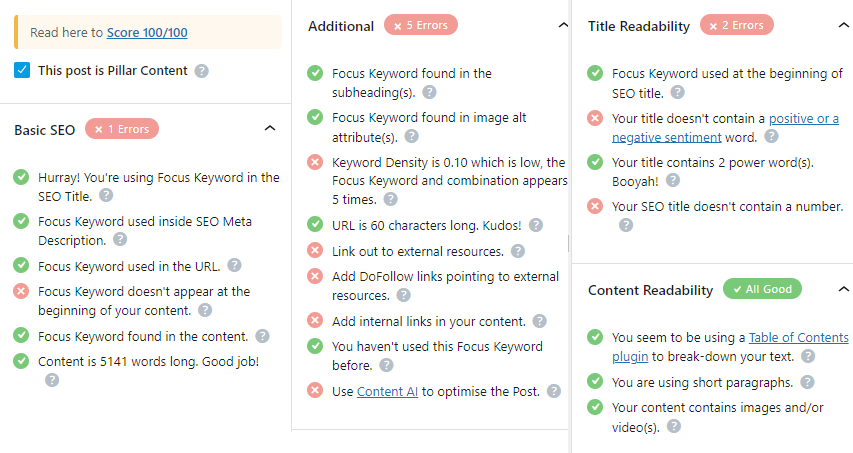
One mistake I have seen many, who use the Rank Math plugin for content optimization, make is stressing themselves over the Rank Math Score. You should understand that when it comes to Rank Math scores, there isn't a specific “good” or “bad” score. What Rank Math does is simply providing a comprehensive SEO analysis of your content and assigning a score based on various factors. This score is meant to give you an indication of how well your content is optimized for search engines.
Instead of focusing on achieving a specific score, it's more important to consider the recommendations and suggestions provided by Rank Math. The tool evaluates factors such as keyword usage, meta tags, content structure, readability, and more. The actionable insights it offers is to help you improve your content and enhance its visibility in search engine results.
While it's natural to strive for a higher Rank Math score, it's essential to remember that SEO is a continuous process of improvement. Aim to implement the recommended changes and optimizations suggested by Rank Math, which will ultimately help enhance your website's performance in search engine rankings and increase organic traffic.
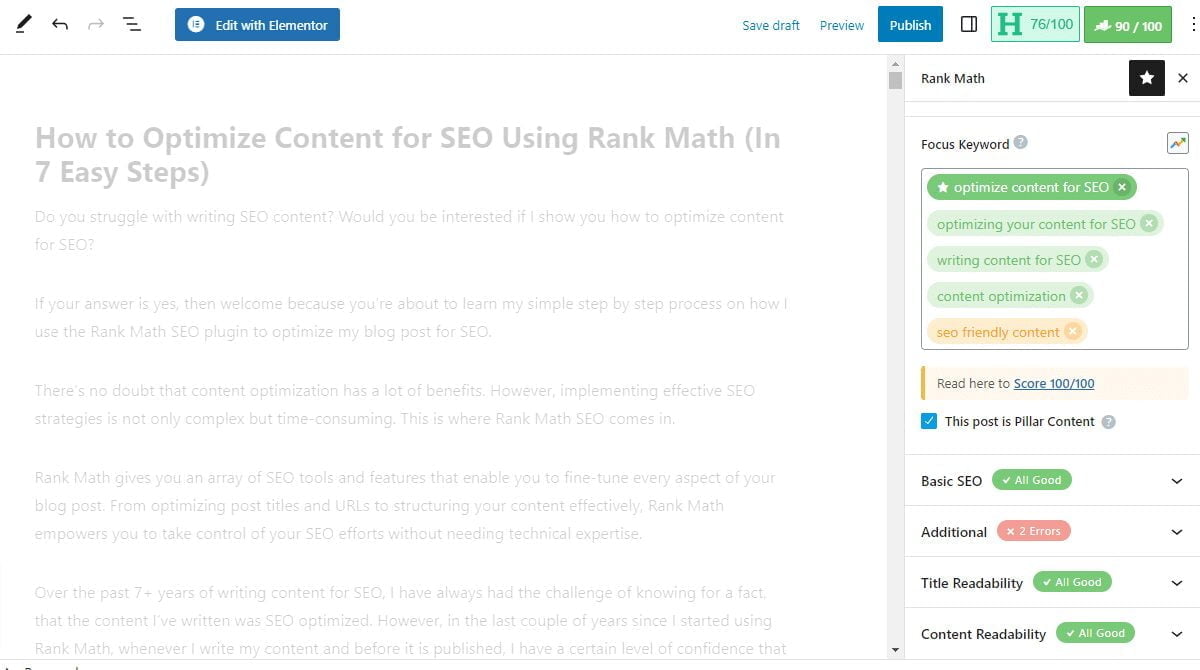
Keep in mind that SEO success is not solely determined by a single tool or score. It's influenced by a combination of factors, including high-quality content, relevant keywords, user experience, backlinks, and overall website optimization. So, instead of fixating on a specific Rank Math score, focus on creating valuable content and implementing effective SEO strategies to achieve your goals
Recommended: 10 Must-Have Content Marketing Tools for Online Business Growth
Frequently Asked Questions
What is a focus keyword in SEO?
A focus keyword, also known as a target keyword, is a specific term or phrase that you want your content to rank for in search engine results. It's the main keyword you optimize your content around to attract relevant organic traffic.
How do I find easy-to-rank keywords?
Finding easy-to-rank keywords involves conducting keyword research using tools like Rank Math or other keyword research tools. Look for keywords with low competition and decent search volume. Long-tail keywords and niche-specific terms can often be easier to rank for.
How does Rank Math Focus Keyword Work?
Rank Math's Focus Keyword feature allows you to specify the main keyword you want to optimize your content for. The plugin analyzes your content, providing suggestions and insights on how to improve your on-page optimization for that particular keyword. It evaluates factors such as keyword density, meta tags, readability, and more.
Is Rank Math good for SEO?
Yes, Rank Math is highly regarded as an excellent SEO plugin for WordPress. It offers a comprehensive set of features and tools to optimize your website and improve its visibility in search engine rankings. With its user-friendly interface and powerful capabilities, Rank Math can greatly assist you in your SEO efforts.
How to score 100 on Rank Math?
Scoring 100 on Rank Math is not the ultimate goal. While Rank Math provides an SEO score, it's important to remember that the score is not the sole indicator of success. Instead, focus on implementing the recommended optimizations suggested by Rank Math, such as optimizing meta tags, content structure, keyword usage, and more. Strive to create high-quality, user-friendly content that caters to your target audience and aligns with SEO best practices.
Is Rank Math Pro worth it?
The decision to upgrade to Rank Math Pro depends on your specific needs and goals. Rank Math Pro offers additional features and functionalities beyond the free version, such as advanced schema markup, advanced SEO analysis, integration with popular plugins, and more. If these features align with your requirements and you seek enhanced SEO capabilities, investing in Rank Math Pro can be worthwhile. Assess your needs and evaluate the Pro version's benefits to make an informed decision.
Conclusion
There you have it, the comprehensive guide on how to optimize your content for SEO using Rank Math. Throughout this post, we explored the importance of search engine optimization (SEO) and how you can leverage Rank Math SEO to create optimized posts on WordPress.
You learned that Rank Math offers a user-friendly content analysis for effectively optimizing your content. From optimizing your content headings and structure for enhanced readability to optimizing your post’s SEO title and URL structure for improved search engine visibility, Rank Math makes the process seamless and efficient.
By implementing the strategies outlined in this article and leveraging the power of Rank Math SEO, you can optimize your blog posts and website content for SEO. This will help you drive more organic traffic, increase your website's visibility, and achieve your online goals.
So, get started with Rank Math today and unlock the true potential of your content marketing!

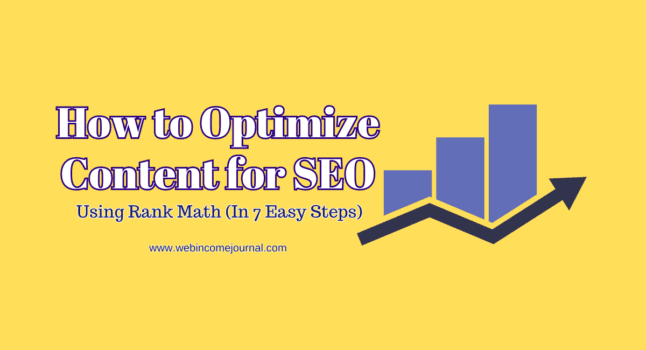






Awesome post man! I think their 404 monitor feature is also very good.